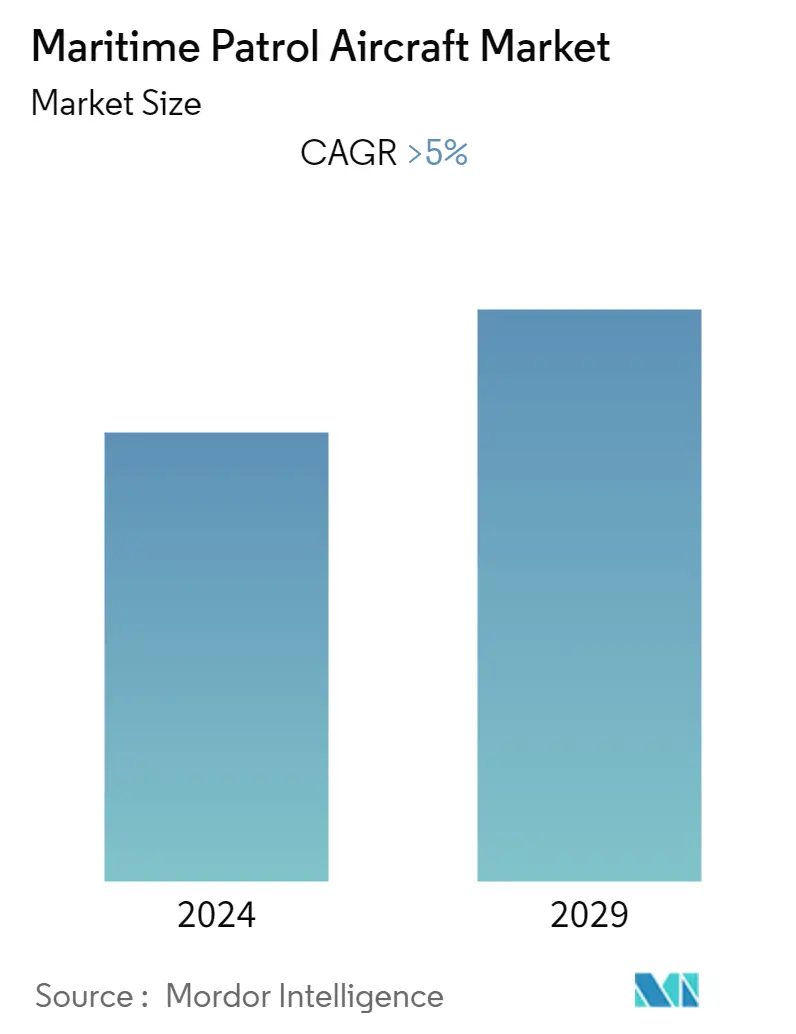Market Size of Maritime Patrol Aircraft Industry

| Study Period | 2019 - 2029 |
| Base Year For Estimation | 2023 |
| Forecast Data Period | 2024 - 2029 |
| Historical Data Period | 2019 - 2022 |
| CAGR | 5.00 % |
| Fastest Growing Market | Asia-Pacific |
| Largest Market | Asia Pacific |
Major Players
*Disclaimer: Major Players sorted in no particular order |
Maritime Patrol Aircraft Market Analysis
The maritime patrol aircraft market is anticipated to register a CAGR of over 5% during the forecast period.
The COVID-19 pandemic impacted the supply chain of certain aircraft programs, which resulted in delivery delays in 2020. However, the situation improved in 2021 for several manufacturers across the world. On the other hand, no visible impact was noted on the orders placed by various naval forces globally.
The increasing threat of terrorism and border issues led the countries to strengthen their maritime surveillance, which may propel the demand for maritime patrol aircraft during the forecast period. The increasing military spending, fueled by the growth of territorial conflicts between the countries, has been one of the prime drivers of the market's growth over the years.
Also, the need to replace aging maritime patrol aircraft used beyond their lifetimes with new and advanced aircraft that have greater patrolling capabilities and can perform anti-submarine and anti-surface warfare is expected to generate demand for the maritime patrol aircraft during the forecast period.
However, the availability of surveillance drones as low-cost alternatives and the growing preference for such UAVs can hamper the market's growth during the forecast period.
Maritime Patrol Aircraft Industry Segmentation
Maritime patrol aircraft are crucial for nations with long coastlines. Modern patrol aircraft with multirole capabilities have become important assets for the global naval forces over the years. Maritime patrol aircraft are typically fitted with a wide range of sensors to perform wide-area monitoring, anti-submarine warfare (ASW), anti-ship warfare (AShW), and search and rescue (SAR) operations. While the demand for modern dedicated maritime patrol aircraft has increased, countries have been preferring low-cost upgrade options to obtain added features for their existing aircraft fleets.
The maritime patrol aircraft market is segmented by engine type and region. For each segment, the market size and forecast are provided by value (USD billion).
| Engine Type | |
| Turbofan | |
| Turboprop |
| Geography | |||||||
| |||||||
| |||||||
| |||||||
| |||||||
|
Maritime Patrol Aircraft Market Size Summary
The maritime patrol aircraft market is poised for significant growth, driven by increasing military expenditures and the need for enhanced maritime surveillance capabilities. The demand is primarily fueled by the rising threats of terrorism and territorial conflicts, prompting countries to bolster their naval forces. The replacement of aging aircraft with advanced models capable of anti-submarine and anti-surface warfare is a key factor contributing to market expansion. Despite the availability of cost-effective surveillance drones, the market is expected to thrive due to the superior capabilities of manned aircraft. The turbofan segment, in particular, is anticipated to experience substantial growth, attributed to its higher engine efficiency and compliance with evolving global aviation carbon emission regulations.
In the Asia-Pacific region, countries like China, Japan, and India are significant markets for maritime patrol aircraft, driven by increased military spending amid regional tensions. The procurement of new aircraft to replace outdated fleets is a common trend, with nations like Japan and China investing in advanced models to enhance their maritime capabilities. The market is highly consolidated, with major players such as Boeing, Lockheed Martin, and Airbus dominating the landscape. These companies are actively developing new variants and upgrading existing models to meet the growing demand for advanced surveillance and reconnaissance systems. Collaborative efforts between manufacturers and governments are further propelling the market, as seen in partnerships aimed at developing next-generation maritime patrol aircraft equipped with modern detection systems.
Maritime Patrol Aircraft Market Size - Table of Contents
-
1. MARKET DYNAMICS
-
1.1 Market Overview
-
1.2 Market Drivers
-
1.3 Market Restraints
-
1.4 Industry Attractiveness - Porter's Five Forces Analysis
-
1.4.1 Bargaining Power of Buyers/Consumers
-
1.4.2 Bargaining Power of Suppliers
-
1.4.3 Threat of New Entrants
-
1.4.4 Threat of Substitute Products
-
1.4.5 Intensity of Competitive Rivalry
-
-
-
2. MARKET SEGMENTATION (Market Size and Forecast by Value - USD billion, 2018 - 2031)
-
2.1 Engine Type
-
2.1.1 Turbofan
-
2.1.2 Turboprop
-
-
2.2 Geography
-
2.2.1 North America
-
2.2.1.1 United States
-
2.2.1.2 Canada
-
-
2.2.2 Europe
-
2.2.2.1 United Kingdom
-
2.2.2.2 France
-
2.2.2.3 Germany
-
2.2.2.4 Rest of Europe
-
-
2.2.3 Asia-Pacific
-
2.2.3.1 China
-
2.2.3.2 India
-
2.2.3.3 Japan
-
2.2.3.4 Australia
-
2.2.3.5 Rest of Asia-Pacific
-
-
2.2.4 Latin America
-
2.2.4.1 Brazil
-
2.2.4.2 Rest of Latin America
-
-
2.2.5 Middle-East and Africa
-
2.2.5.1 Turkey
-
2.2.5.2 United Arab Emirates
-
2.2.5.3 Rest of Middle-East and Africa
-
-
-
Maritime Patrol Aircraft Market Size FAQs
What is the current Maritime Patrol Aircraft Market size?
The Maritime Patrol Aircraft Market is projected to register a CAGR of greater than 5% during the forecast period (2025-2030)
Who are the key players in Maritime Patrol Aircraft Market?
The Boeing Company, Lockheed Martin Corporation, Airbus SE, Textron Inc. and Dassault Aviation SA are the major companies operating in the Maritime Patrol Aircraft Market.

